


Christmas Store
The holidays are just around the corner so now is the time to fetch the finest gifts for the Labrador Lover on your Christmas list. We have over 100 gifts $50.00 and under. Visit our Christmas Store.
For the Lab
Bedding
Coats
Collars and Leads
Dog Bowls
Feeding Stations
Spa and Grooming
Toys and Treats
Travel and Accessories
For the Lab Lover
Apparel
Cards and Giftwrap
Fine Accessories
Gifts and All Occasions
Jewelry
Kids Only
For the Lab Home
Artwork
Books
Garden and Outdoor
Home Furnishings
Kitchen Accessories
Pillows, Throws, and Rugs
Gift ServicesGift Boxes
Gift Certificates
Hiking With Your Lab
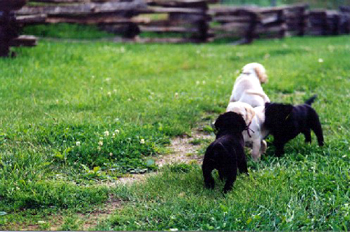
Ever meet a Lab that didn’t like to hike and explore? Even as puppies they love taking off to investigate their surroundings. With their keen sense of hearing and smell, your Lab can make a great hiking companion. Almost any dog that is in good health and well trained to obey basic commands can become a wonderful hiking and camping canine compadre.
Conditioning Your Lab
Just like any other physical activity, you will want to prepare yourself and your Lab for a hiking trek. If your Lab isn’t accustomed to strenuous exercise, it’s important to start out slowly. Begin a training schedule that may consist of walking your dog around the neighborhood and gradually increasing the distance as you and your Lab become conditioned. Find a route that provides changes in terrain to help stretch muscles which may not have been used regularly. A log book can help to keep track of the distance, weather, trail conditions and your Lab’s conditioning.
Hiking Basics
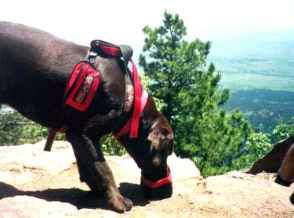
- Be sure your Lab’s rabies vacation and flea and tick control are up–to-date. It’s always a good idea to ask your vet about other medical precautions against diseases such as Lyme disease or Rocky Mountain spotted fever.
- A collar with identification tags is a must. Be sure your Lab is wearing all of his identifying information, including your name and phone number in the event you are separated.
- Use a leash. Most hiking areas require that dogs be leashed. Even where not required, many hikers find it helpful leashing their dogs to keep them from running off in pursuit of wildlife. Carrying a spare collar and leash in your pack can be very useful in case of breakage.
- Remember a first aid kit for yourself and Fido. You can purchase a small ready made kit that will fit into your pack or put together basic supplies such as: alcohol wipes, antibiotic cream, tweezers, eye wash, gauze, adhesive tape, bandages or sock, a disposable razor for shaving the fur from around a wound and your vet’s phone number.
- Pack extra water. Dogs can’t cool off by perspiring like we do. Clean drinking water is essential for you and your Lab. A rule of thumb is to carry 8 ounces of water for every hour of hiking. Never let your Lab drink from streams or ponds on the trail which may contain giardia or dangerous bacteria. Pay attention to your Lab’s condition and guard against heatstroke.
- Bring along plastic bags to pick up after your dog or bury your dog’s scat away from the trail and topical water sources.
- Dog booties can be an asset, especially for rough terrain or the occasional dog hiker whose paw pads have not become toughened. Many trails unfortunately have broken glass on them and in winter time, dog booties can keep ice balls from forming between your dog’s toes.
- Make a habit of checking your dog at the end of each hike for any slight injuries to the pads of their feet, eyes and for ticks.
Backpacking Basics
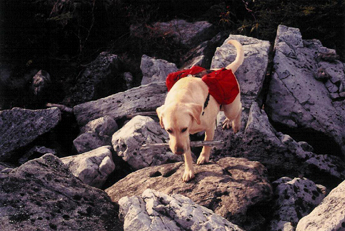
Dogs can carry a good deal of weight on their backs, which can be helpful trekking across country. Consider your Lab's age and body weight to determine how much they can carry. A healthy, well-conditioned Lab can comfortably carry 25% to 33% of its body weight. However, young or aged dogs may only be able to carry between 10 to 15 percent of their body weight. If your Lab has any back problems or dysplasia, he should not wear a dog pack.
- To select an appropriate dog pack, measure your Lab’s girth around the rib cage to determine the best pack size. Dog packs are usually sized from small to large, with weight specifications so it is important to know your Lab’s weight before going to purchase the pack.
- A dog pack should fit securely without hindering the dog’s ability to walk normally. Get a pack which places the weight over your dog’s shoulders as the shoulders are built to carry weight, not the spine. Prioritize comfort and weight as your primary considerations when selecting a dog pack.
- You will want to be sure to have a non-restrictive harness on your pack. (Non-restrictive means that the dog’s shoulder movement is not impeded by any kind of horizontal strap across the front.) Whether you want padding or not will depend on the weight and the amount of pulling your dog will do. Some packs are padded under the saddlebags, and some are padded around the neck and chest areas of the harness.
- Packs should be made from a lightweight, water-proof material, with adjustable nylon web straps and quick-release buckles for ease in getting on and off. A high visibility color, like orange, red or royal blue will help you spot your dog from a distance.
- When you start having your dog carry his pack, start with an empty pack and add weight gradually with each trip. Fill the pack with treats and reward your dog for his effort from his stash. Soon your Lab will associate the dog pack with an outdoor adventure and will eagerly look forward to wearing it.
- Don’t put anything in a dog pack that can break. Dogs will bang the pack on rocks and trees as they wiggle through tight spots in the trail. Low density items such as food and poop bags are good choices.
- Dogs like to lie down in creeks and other wet spots so seal items in plastic bags. Bring an extra towel for your Lab since he may get muddy or roll in something foul.
- It is easy for a pack to shift position if your dog has to maneuver through brush and rocks, so check your dog’s pack position regularly.
Camping Basics
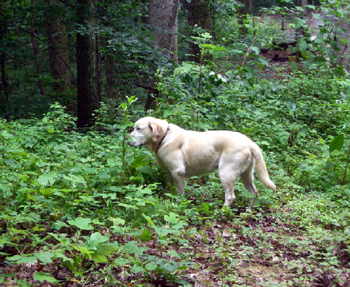
Camping outside under the stars can be one of the best places to spend time with your Lab. If you are thinking about taking your Lab camping, here are a few more tips that may make camping with your Lab a bit more enjoyable.
- Some campgrounds don’t allow dogs. Call ahead to your intended destination and find out what the rules are before you make plans to bring your Lab.
- Remember that other campers want to enjoy the peace and quiet of an out-of-the-way campground, so leave the persistent barker at home with a friend or pet sitter.
- Obtain the phone number of a vet in the area where you will be staying for unexpected situations and bring any medications and a copy of your Lab’s prescriptions.
- If you intend to drive into the campground and have short day hikes you can bring more items with you.
- Don’t forget to pack plenty of water from home for your Lab. Bring their regular food bowls, food, treats and toys.
- Try to keep them on their regular feeding schedule and remove any leftover food after your dog eats. This food could attract unwanted insects or wildlife.
- Try to get a site with some shade for your Lab and give them time to adjust to their new surroundings.
- Never leave your dog outside unattended.
- Pack a lightweight portable crate and pad for those chilly nights if your Lab won’t be sharing your tent.
- Be aware of how weather conditions affect your Lab—heat, cold, rain etc. Give them time to rest.
Trail Etiquette Basics
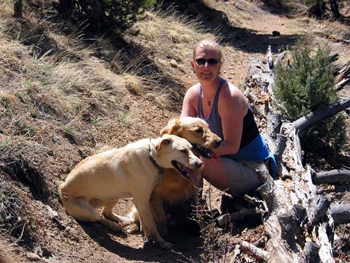
Every time you hike with your Lab on the trail you are an ambassador for all dog owners. Some people you meet won’t agree with your right to take your Lab with you on the trail, but be friendly to all and leave the best impression of you and your Lab by practicing good trail etiquette basics.
- Make sure your Lab is obedience trained in the basics and understands voice commands.
- Hike only where dogs are allowed.
- Stay on the trail.
- Step off the trail and wait while other hikers or horses pass.
- Do not leave your dog’s scat on the trail. If you haven’t brought plastic bags, bury it away from the trail or topical water sources.
- Do not allow your dog to bark –other hikers are enjoying the trail for serenity.
- Pack out everything you pack in and if necessary, pack out the trash left by inconsiderate visitors before you. A good use for dog packs on day hikes is trail maintenance.
- Enjoy the hike as much as your Lab does.
A Quick Primer for Hiking with Dogs on Federal Lands
Article written by: Doug Gelbert
Author of “The Canine Hikers Bible”
National Parks
As a general rule, dogs in national parks are welcome to go "anywhere a car can go." This means your dog can hike along roadways and walk around parking lots. In most parks dogs can also go in picnic areas and stay in campgrounds. Occasionally dogs will be permitted on short trails around a Visitor Center or a campground.
National Monuments
These parks are a notch below in national parks in terms of prestige and are a mixed bag for active dog owners. Some, like Dinosaur National Monument or White Sands National Monument, allow dogs on most trails while others, Devil's Tower or Cedar Breaks for instance, ban canine hikers from all trails.
National Forests
National forests, under the stewardship of the Department of Agriculture and not the Department of the Interior like national parks, offer the meatiest hiking opportunities for dog owners. Dogs are permitted on most national forest trails, although access can sometimes be remote. Many times national forest lands surround national parks so you can get your dog on a trail after being cooped up there.
National Grasslands
These parks are cousins of national forests and you can expect to have your dog accompany you on your hike. Hiking opportunities are limited, however, as there typically aren't many trails in a national grassland.
National Recreation Areas
As the name implies, these lands are managed to maximize public use - for humans and dogs. Many trails in national recreation areas are open to off-road vehicles, mountains bikes, and horses. These types of trails will invariably be open to dogs as well. You can expect to find good canine hikes in almost any national recreation area.
National Seashores and Lakeshores
Dogs are seldom allowed on trails at a national seashore but happily most (the southeastern national seashores are an exception) allow dogs on the beach year-round. National lakeshores are good bets for canine hikers as dogs are allowed on many trails in these parks along the Great Lakes.
National Historical Parks
These parks are hidden gems for canine hikers. There are few bans on dogs in national historical parks. In addition to learning a thing or two about American history, these parks often feature interesting hiking: the rolling hills of eastern Pennsylvania in Valley Forge Historical Park, the mountains of Harpers Ferry Historical Park, the wild Potomac River of the Chesapeake & Ohio National Historical Park to name a few.
Trails End:
For those avid outdoor people who love to hike and explore the beauty of God’s creation with their Labs, check out www.hikewithyourdog.com/besthikes.html for more information on great hiking places through United States and the British Columbia.
 Can You Spot The Holiday Hazards?
Can You Spot The Holiday Hazards?It’s easy for pets, especially Labradors, to get into trouble during the holidays. You may get so busy that you lose track of what is going on with your dog.
Click here to learn more about: "Can You Spot The Holiday Hazards?"

Would you like to see your Lab pictured here? Send us images of your Lab and we may include them on our Home Page!
Labrador Links
The Verstaile Lab
History of the Lab
Advice
Travel
Featured Labs
Featured Artists
.jpg)

